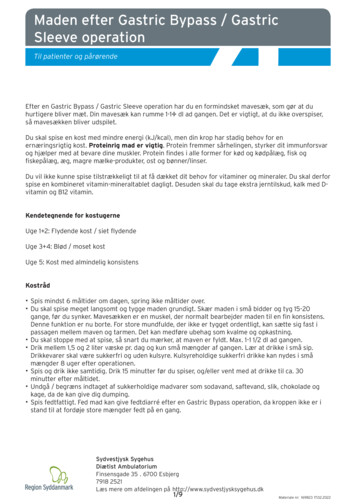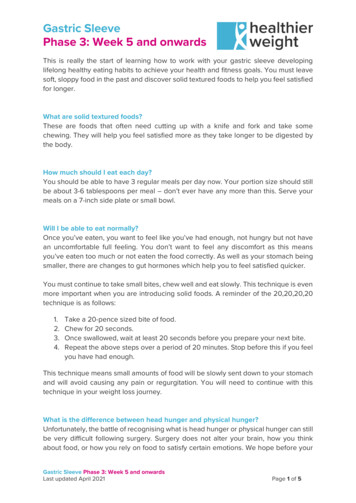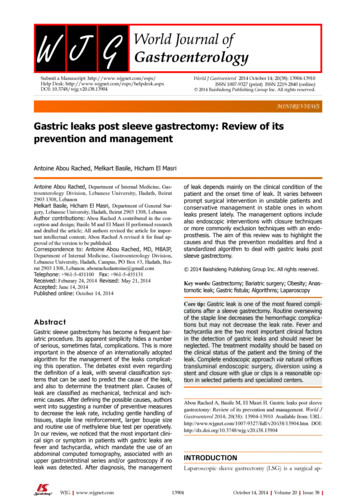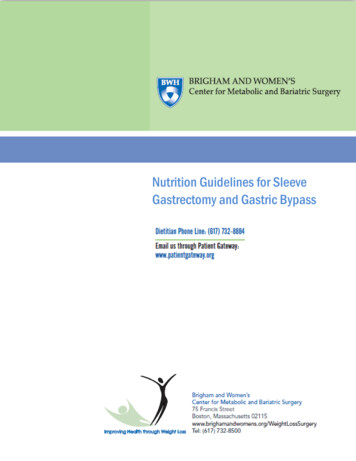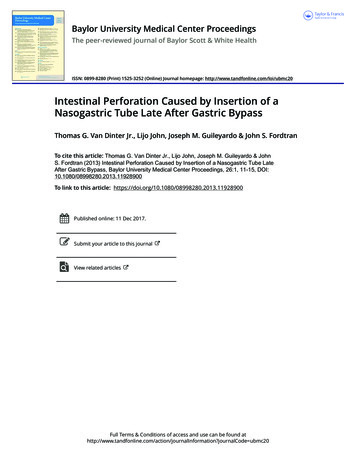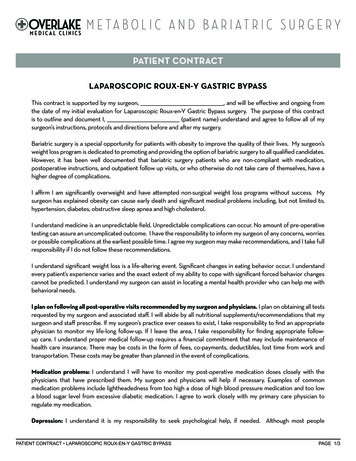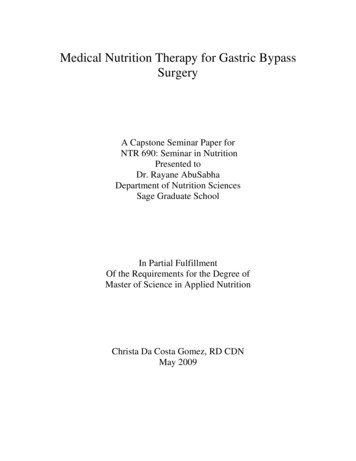
Transcription
Medical Nutrition Therapy for Gastric BypassSurgeryA Capstone Seminar Paper forNTR 690: Seminar in NutritionPresented toDr. Rayane AbuSabhaDepartment of Nutrition SciencesSage Graduate SchoolIn Partial FulfillmentOf the Requirements for the Degree ofMaster of Science in Applied NutritionChrista Da Costa Gomez, RD CDNMay 2009
As the faculty advisor, I approve the thesis ofDate of Signature:Christa Da Costa GomezDr. Rayane AbuSabhaAssociate Professor of NutritionThesis Advisor2
Table of ContentsPageABSTRACT 5CHAPTERI. Introduction .71.1 Definition and Classification of Overweight and Obesity 101.2 Treatment Options for Obesity .10II. Non-Invasive Weight Loss Methods . 132.1 Diet Therapy .132.2 Physical Activity .162.3 Behavior Therapy .222.4 Pharmacotherapy .27III. Weight Loss Surgery .313.1 Laparoscopic Banding .313.2 Vertical Banded Gastroplasty .333.3 Duodenal Switch .353.4 Roux-en-Y Gastric Bypass .35IV. Nutritional Concerns Pre and Post Roux-en-Y GastricBypass Surgery .434.1 Macronutrient Post-Operative Deficiencies . 444.2 Micronutrients: Vitamins Post-Operative Deficiencies 454.3 Micronutrients: Minerals Post-Operative Deficiencies 473
V. Nutrition Recommendations Pre and Post Roux-en-Y GastricBypass Surgery .485.1 Pre-Surgical Guidelines 485.2 Post-Surgical Guidelines .49VI. Summary . 56TABLESTable 1:Prevalence of Selected Chronic Conditions According toBody Mass Index (BMI) .Table 2: Body Mass Index Classifications .811Table 3:Systemic Review of Major Commercial Weight LossPrograms in the United States 14Table 4:The Effect of Diet and Exercise on Short and Long TermWeight Loss .19Table 5:Weights of a 5’3” and 5’10” person with varying BMI .21Table 6:Overview: Operations Performed for Treatment of Obesity.41Table 7: Post Operative Diet Guideline Summary .50FIGURESFigure 1: Laproscopic Banding Surgery . 32Figure 2: Vertical Banded Gastroplasty . 34Figure 3: Duodenal Switch Procedure . .36Figure 4: Roux-en-Y Gastric Bypass Procedure . 374
AbstractObesity has become a major public health concern in the United States, and costof treatment is rising. The available non-surgical interventions such as diet, physicalactivity, behavior therapy, and pharmacology, show minimal long term benefit for weightreduction. Non-surgical interventions used individually or together rarely produce longterm weight loss above 15 lbs. For example, the average weight loss attributed to drugsis reported to range between 4 and 22 lbs with most of the weight loss being limited tothe first 6 months of treatment. Patients who are obese (Body Mass Index 30) needmore drastic methods to achieve significant weight loss. Many obese patients electweight loss surgery, specifically Roux-en-Y gastric bypass surgery. Roux-en-Y is thepreferred surgery and is commonly performed in the United States. Other surgicalprocedures have not suggested the same amount of weight loss, long term maintenance,and health outcomes that Roux-en-Y has.Weight reduction statistics for bariatric surgery, including Roux-en-Y, areimpressive, averaging close to 100 lbs over 5 years post-operatively. In addition, comorbidity improvement has been shown with bariatric surgery. Literature confirms thatdiabetes resolution occurs in over 80% of patients, hyperlipidemia improvement occurs inover 95% of patients, and hypertension/sleep apnea improvement is demonstrated in over70% of patients. Gastric bypass surgery, including Roux-en-Y, has its risks and thepatient should be closely monitored. The gastric bypass surgical candidate should bescreened by the interdisciplinary team, including the Registered Dietitian (RD). Dieteticprofessionals must be familiar with the anatomical changes after gastric bypass surgery,as well as with the pre- and post-operative medical nutrition therapy. The RD should be5
involved in follow-up care to ensure optimal weight loss results with minimal nutritionrisk. There is a need for standardized nutrition protocols to monitor and treat bariatricsurgery patients.6
Chapter 1IntroductionThe National Health and Nutrition Examination Surveys (9), data has shown that,over the past few decades among US adults ages 20 to 74, prevalence of overweight andobesity has increased from 15% (1976-1980) to 32.9%, (9). The increasing prevalence ofoverweight and obesity has many health implications, including increased risk ofhypertension, Type 2 Diabetes, dyslipidemia, Coronary Heart Disease, stroke, gallbladderdisease, osteoarthritis, sleep apnea, and certain cancers (breast, colon, and endometrial ).Table 1 illustrates the increase in prevalence of certain chronic conditions withobesity (9). There is an increased prevalence of high total cholesterol, low levels of HighDensity Lipoprotein, and high blood pressure in those individuals with a Body MassIndex greater than 30. Research suggests that life expectancy could be increased by up to0.93 year for white men, up to 0.81 year for white women, up to 1.08 year for black men,and up to 0.73 year for black women if obesity was non-existent (28).Annual medical spending due to health complications resulting from a BMIgreater than 25 was suggested to be as much as 92.6 billion dollars in 2002 – 9.1% of USHealth Expenditures (12). With the continued rise in obesity, this estimated cost willcontinue to increase.7
Table 1. Prevalence of Selected Chronic Conditions According to Body Mass Index(BMI). Data based on NHANES III (1988-1994)ConditionPercent Prevalence of Conditionsaccording to BMINormal weightObese(BMI 25)(BMI 30)%High Blood Pressure - Male18.339.2High Blood Pressure - Female16.232.4High Cholesterol – Male14.720.2High Cholesterol - Female14.624.3Low HDL - Male9.331.5Low HDL - Female16.3428
Healthy People 2010 objectives (33), define three goals for reducing prevalenceof obesity: 1) To increase the proportion of adults aged 20 and older who are at a healthyweight to 60% from a baseline of 42%. 2) To reduce the proportion of obese adults aged20 years and older to 15% from a baseline of 23%. 3) To reduce the proportion ofchildren and adolescents, age 6 to 19, who are overweight and obese to 5% from thecurrent baseline of 11%. Unfortunately, data indicate that the levels of overweight andobesity in the U.S. are still headed in the opposite direction.A sleuth of dietary and behavioral programs and aids have been developedto assist individuals lose weight. For the most part, many of these weight loss programsand weight loss medications have not produced significant losses in the majority ofindividuals. As a result, many obese individuals turn to surgery, currently the mosteffective solution to shed extra pounds.The purpose of this review is to examine medical nutrition therapy for weight losssurgery, including defining the role of the registered dietitian (RD). The review begins bydefining overweight and obesity. A discussion of current treatment methods such as diettherapy, physical activity, behavioral therapy, pharmacology, and weight loss surgeryfollows. Nutritional concerns and complications that accompany weight loss surgery,specifically Roux-en-Y surgery, will be examined including medical nutrition therapyrecommendations and the role of the RD. Roux-en-Y surgery will be examined inparticular because it is the most widely performed procedure due to its safety andeffectiveness.9
1.1 Definition and Classification of Overweight and ObesityWhile overweight is an excess accumulation of energy that leads to increasedweight, obesity is overweight accompanied with increased adiposity. In 1998, a NationalInstitutes of Health (NIH) panel of experts recommended the use of the Body Mass Index(BMI) to define and classify obesity (26). BMI is calculated using height and weight ofan individual and is based on the following formula:BMI weight (kg)/ ((height (m) 2)BMI may be reported in pounds (lb) using the following conversion:BMI weight (lb)/ ((height (in) 2) x 703Although BMI represents a crude measurement of obesity, it correlates well withthe amount of body fat in the majority of individuals (9). In addition, it is an inexpensive,easy to use formula for clinicians that has been widely adopted. The BMI cut-offsdefined by NIH are shown in Table 2.1.2 Treatment Options for ObesityThe National Heart Lung and Blood Institute (NHLBI) reports goals for weight loss andmaintenance for adults who are overweight and obese (BMI 25 and over). The goal oftreatment is to, at minimum, prevent further weight gain while ideally promoting gradualweight loss and long term maintenance of a healthy weight to decrease chronic disease10
Table 2. Body Mass Index ClassificationsBMI (Kg/m²)Weight Classification 18.5Underweight (thin)18.5-24.9Normal weight25-29.9Overweight30-39.9Obesity 40.0Morbid Obesity11
risk. Initial weight loss goal should be a 10% reduction in weight from baseline,achieved within approximately six months. To achieve the 10% weight loss in a 6-monthperiod, those with a BMI of 27-35 are to decrease caloric intake by 300-500 calories perday, promoting a ½ to 1 pound weekly weight loss. Those with a BMI over 35 are todecrease caloric intake by 500 to 1,000 calories per day, promoting a 1-2 pound weeklyweight loss.Strategies for weight loss include dietary therapy, physical activity, and behaviortherapy. In addition to the aforementioned, pharmacotherapy and surgery may beappropriate in carefully selected patients. Each of these strategies will be discussed in thesections below.12
Chapter 2Non-Invasive Weight Loss MethodsThe most popular non-invasive weight loss methods mainly include dietarytherapy, physical activity, behavior therapy, and pharmacotherapy. Each will bediscussed in this Chapter.2.1. Diet TherapyDiet therapy involves decreasing caloric intake over a period of time to promoteweight loss. A plethora of diet therapy programs have been promoted, including low–fatdiets, low-carbohydrate diets, and very low calorie diets. Diet therapy programs typicallypromote low calorie diets (LCD), approximately 500 to 1,000 kcal/day deficit (26). TheLCD is achieved by reducing carbohydrates and fats (especially saturated fats) in the diet.Various diet therapies available in the United States utilize the LCD to elicit weight loss,including Weight Watchers, Optifast, Take Pounds Off Sensibly (TOPS), eDiets.com andHealth Management Resources. Success of weight loss is measured by percent bodyweight loss achieved and ability to maintain the loss long term (more than one year).Table 3 reviews popular diets in the United States, treatment modality, andmaximum/long term weight loss for each diet.As illustrated in Table 3, long term weight loss with popular diets producesminimal weight loss, if not weight gain as seen with Weight Watchers and TOPS . Theaverage long term weight loss is often less than 10% of initial body weight. While thismodest weight loss may produce a decrease in health risks, it is not motivating to the13
Table 3. Systemic Review of Major Commercial Weight Loss Programs in the USProgramDietPhysical ActivityBehavior ModificationWeightLow-calorie exchange diet“Get Moving” bookletBehavioral weight controlWatchers(points); self-preparedprovidedmethods discussedMaximum weightLong term weightchange (% initialchange (% initialbody weight lost)body weight lost)5.3 % at 26 weeks3.2% at 2 years-19.2% at 15.5 weeks-7.3% at 3.4 years-19.9% at 26 weeks-4.7% at 4.5 years-0.9% at 16 weeks-1.1% at 1 yearmealsHealthLow-calorie or very low-Walking and calorieIncluded in lifestyle classes;Managementcalorie diet provided viacharts provided inaccountability and skillResourcesmeal replacementslifestyle classesacquisition emphasizedOptifastLow-calorie diet providedPhysical activityIncluded in lifestyle classes;through meal replacementmodules provided instress management and sociallifestyle classessupport emphasizedLow-calorie diet providedPhysical activityIncluded in eDiets.comthrough “virtual dietitian” ;seminar throughUniversity; stressclient prepares mealseDiets.com Universitymanagement emphasizedeDiets.com14
Table 3 (Continued). Systemic Review of Major Commercial Weight Loss Programs in the USProgramDietPhysical ActivityMaximum weightLong term weightchange (% initial bodychange (% initialweight lost)body weight lost)Included in curriculum0.4% at 12 weeks1.6% at 1 yearAs presented in bookAs presented in book-6.7% at 6 months-5.5% at 1 yearAs presented in bookAs presented in book-2.7 % at 2 months-1.9% at 1 yearTake OffLow-calorie diet exchangeMembers plan withPounds Sensiblyplantheir health care(TOPS)AtkinsBehavior ModificationproviderVery low-carbohydrate diet,no caloric restriction, 1 hourclass with RegisteredDietitian, copy of book (Dr.Atkins new diet revolution)ZoneLow carbohydrate diet,caloric restriction, 1 hourclass with RegisteredDietitian, copy of book(Enter the Zone )**subjects reviewed in these studies had mean BMI’s 30, greater than 35 in most cases. (Adopted from: Tsai & Wadden, 2005, Gardner, et al. 2007)15
morbidly obese, who may have to lose 50% of their body weight to reach overweightstatus. In addition, lack of success of these weight loss programs tends to promote asense of failure in the dieter which may impact future attempts to lose weight.Many health professionals and scientists maintain that including lifestyle changes, suchas exercise, and behavior modification result in more successful weight loss that can bemaintained over time as opposed to diet therapy alone. The following sections explorethe benefits of adding physical activity and behavior modification to a weight lossprogram.2.2. Physical ActivityPhysical inactivity and poor diet have been identified as a leading cause of deathin the United States (25). Health benefits of physical activity include increased physicalfitness, maintenance of healthy bones, muscles, and joints, weight management,controlled blood pressure, lower risk of cardiovascular disease, colon cancer, and type 2diabetes, reduction of depression and anxiety, and increased self-esteem. Chronic positiveenergy balance leads the body to store excess as fat. Regular physical activity is known toelicit metabolic changes in muscle and fat tissue that promote fat usage instead of storage(20).Hansen et al. (17) conducted a comprehensive meta-analysis of endurancetraining and resistance training and their effect on fat mass loss. Studies were selected inwhich subjects were obese (BMI 30) and 19 years of age or older. Twenty-one studieswere reviewed to determine the effect of endurance training in addition to caloricrestriction. Four of the 21 studies suggested greater fat mass (adipose tissue mass) loss16
among obese subjects, primarily women, who expended 105-288 calories daily viaendurance training for a period of 5 to 14 weeks. Nineteen studies were reviewed todetermine the influence of various training modalities on fat mass loss during caloricrestriction. Two of 19 studies suggested greater fat mass loss with high levels of training(session volume 400 minutes per week and caloric expenditure of 2500 kcal per week) asopposed to moderate level of training (session volume 210 minutes per week and caloricexpenditure of 1000 kcal per week) at 12 and 18 months. Endurance and/or resistancetraining did not have a statistically significant effect on reducing fat mass. Fat mass lostwith strength training, though not significant, was central adipose as opposed to visceraladipose, a valuable observation since central adiposity is predictive of cardiovasculardisease. The authors concluded that resistance training is beneficial as it maintains leanbody mass and metabolic rate, whereas low caloric intake alone produces a decrease inlean body mass as well as metabolism. At 30 months, participants who engaged in highlevels of exercise (2500 kcal/wk expenditure) were able to maintain a significantly higherweight loss [15.4 pounds (7 kg) average] than subjects in the standard behavioral therapygroup at 30 months (p 0.001) (31) suggesting that a high level of physical activity isbeneficial in maintaining weight loss.Further research is ongoing to determine the role, if any, of physical activity inappetite suppression and food intake, beneficial effects of endurance and resistancetraining, and impact of level of exercise and effect on weight loss/maintenance.Cucurioni & Laurenco (10) reviewed nine studies to determine the effectivenessof diet and exercise vs. diet alone in overweight and obese individuals. Studiesconsidered were randomized, controlled clinical trials of diet (defined as any type of17
caloric restriction), exercise (quantifiable activity), or diet and exercise with subjectshaving a BMI greater than 25 (overweight and obese). Studies were excluded if follow upperiod was less than one year, medications were used, or if behavior therapy was the onlyintervention used. The sample size of studies examined ranged from 40 to 127 subjects.Age ranged from 21 to 65 years old, with primarily women subjects. Length of treatmentranged from 10 to 52 weeks, and follow up ranged from 12 to 24 months. Results areshown in Table 4 and indicate that diet and exercise produce a 20% greater weight loss(initial and at one year) than diet alone, which the study found to be significant by zvalues greater than 1.5.Changes in body composition after a three week weight reduction program wereexamined in inpatient obese men and women (23). Seventy obese volunteers werereferred to the Third Division on Metabolic Diseases (Italian Institute) by physicians forin-patient treatment of obesity. Volunteers were selected based on age (over 18 yearsold), BMI (greater than or equal to 35), absence of major disease, and motivation to takepart in a structured weight loss program. Six participants (one male, five females)dropped out for various reasons throughout the weight reduction program and follow-up,leaving sixty-four participants for analysis. The body weight reduction program was acombination of an energy restricted diet, nutrition education, psychological counseling,and moderate physical activity (five training sessions per week consisting of aerobic (30– 40 minutes) and strength training (15 repetitions on three machines) coordinated by theappropriate professionals (dietitians, exercise physiologists, physicians, etc.). At the endof the three week inpatient program, fat mass was reduced by an average of 7.1 kg. At18
Table 4. The Effect of Diet and Exercise on Short and Long-term Weight Loss (N 9). Initial weight loss is defined as weight loss immediately after intervention (10-52weeks). Standard deviations (SD) are presented in parentheses.Initial Weight Loss inWeight Loss after OneKg (10-52 weeks)Year in KgDiet and Exercise-13.0 (10.4)*-6.7 ( 8.3)**Diet Alone-9.9 ( 9.6)-4.5 (11.3)* z 1.86 (z 1.5 is significant)**z 1.89 (z 1.5 is significant)19
follow-up (approximately 11 months later), no significant changes in fat mass reductionwas noted, and participants were broken down into a weight regain and a weight lossgroup. Those in the weight loss group were analyzed, and the correlation was made thatthey had higher physical activity levels. The study shows that with the use of strengthtraining, restricted caloric intake, and nutritional and psychological counseling, anappropriate weight loss may be achieved for the short term. Unfortunately, this is yetanother study that is unable to show significant weight loss over a long period of time,especially in the obese population, despite the addition of physical activity. Moreover,interventions in this study occur in an inpatient setting, unrealistic for the generalpopulation.While dieting and exercise together produce more weight loss than dieting alone,the additional weight lost caused by the incorporation of exercise is minimal, amountingto about only 2 lbs after one year (Table 4). Again, this small amount of weight loss maywork for mildly overweight individuals but not for the obese who have significantly morepounds to lose. Table 5 presents the weights in pounds of a 5’3” woman with varyingBMI levels. The table illustrates the amount of weight that needs to be lost to achieve anormal BMI of 24 or 10% of body weight. As shown, a person with a BMI of 27 orabove has over 15 pounds to lose to achieve 10% weight loss. To reach a normal BMImore pounds need to be shed. This weight is significantly higher than the 6 poundaverage weight loss typically achieved at one year with exercise and diet (See Table 5).Exercise and diet alone are not sufficient to achieve the 10% weight loss or the normalBMI for anyone with a BMI of 27 or more. These numbers are magnified for tallerindividuals.20
Table 5. Weights of a 5’3” and 5’10” Persons with Varying BMI Levels.5’3” HeightBMI5’10” HeightWeightWeight Loss10%Weight inWeight Loss10%in lbto reachweightlbto *Normal BMI is calculated as BMI 24** 10% weight loss (14 lb) is not necessary since it exceeds the pounds needed toachieve normal BMI.21
Despite the incorporation of physical activity, diet and exercise does not work formost people. This section is not attempting to minimize the value of exercise in asensible weight management program. While physical activity may not lead tosubstantial losses in weight, it is essential to preventing weight regain and needs to becombined with diet therapy to produce optimal results, especially for marginallyoverweight individuals. Unfortunately, the majority of individuals do not adhere longenough to the regimen of diet and exercise and often revert to their old habits ofsedentary lifestyle and overeating. In addition, the weight loss achieved is minimal whenconsidering obese individuals with a substantial amount of pounds to lose.It is evident that, for obese individuals, more drastic measures need to beundertaken to achieve more significant weight loss. The next section explores theaddition of behavior modification to a diet and exercise regimen and investigates the roleof accountability in achieving long term weight loss.2.3. Behavior TherapyBehavior therapy comprises a variety of concepts including self-monitoring ofcaloric intake and physical activity, stress management, stimulus control, problemsolving, contingency management, cognitive restructuring, and social support. Theseconcepts may be used in combination with each other or independently based on theindividual.22
Self-monitoring, by recording daily intake and antecedents of eating, helpsindividuals keep track of their calories and slow down or stop their intake when caloricintake approaches daily recommendations. Energy expenditure should also be recordedin those who self-monitor. Behavioral goal setting should include realistic andchallenging goals to keep the client motivated. Stimulus control involves identifying cuesfor undesirable behavior and reducing them while increasing cues for desirable behavior(11). Problem-solving can be helpful to work through a particular barrier. It includes:identifying the problem, evaluating the chain of events leading to the problem, andidentifying a link to change in order to prevent the outcome. Cognitive restructuringattempts to increase motivation by enhancing positive thoughts and replacing negativethoughts. Social support can increase adherence to a lifestyle change. Stress managementcan prevent emotional eating and resulting increased caloric intake if non-food behaviorsare substituted for food related behaviors.The importance of self monitoring was demonstrated by Baker and Kirschenbaum(3) who followed 56 participants for 18 weeks enrolled in a long term cognitive behaviortreatment program (The People at Risk (PAR) weight control program). Cognitivetherapy uses psychosocial therapy with a focus on changing thoughts (cognitive patterns)to solve problems. At the initiation of this investigation, or sub-study, participants hadalready been enrolled in the PAR weight control program approximately 40 weeks andhad lost approximately 21 lbs (9.5 kg). The average weight of participants was 246.5 lbs(112 kg). Subjects were provided a self-monitoring book to record all food andbeverages consumed daily. Weekly weigh-ins and self-monitoring books were reviewed23
at weekly sessions. Individual (15 participants) and group (45 participants) behaviorcontracting and training programs during weekly meetings focused on decision making,planning, and relapse prevention. Self-monitoring records of each participant were ratedand separated into quartiles based on monitoring consistency. Results indicated thatparticipants who monitored intake more than 76% of the days achieved a mean weightloss of 15kg (33lbs) whereas the lowest quartile of monitoring (fewer than 25% of thedays) achieved a 4kg (8.8lb) weight gain. The weight loss is particular to the sub-study,and would be additional to the PAR weight loss obtained prior to initiation of the substudy. The sub-study confirms the authors belief that participants who self-monitorintake regularly achieve the highest weight loss, and those who do not regularly monitorintake achieve the lowest weight loss (or experience weight gain, as in this example).The general population underestimates caloric intake by 8-34% and for thosereporting an inability to lose weight, up to 50% underestimate their energy intake (11).The discrepancy may be up to 34% for the general population, and up to 50% for peoplewho report that they cannot lose weight. Thus, close monitoring of one’s intake may helpdieters be more aware of actual intake and possibly limiting overeating.A controlled trial of very low calorie diet and behavior therapy examined 59 menand women who responded to a newspaper advertisement seeking subjects at least 25 kgoverweight. Subjects underwent medical evaluation and were stratified into threetreatment conditions by random assignment: very low calorie diet alone, behavior therapyalone, and very low calorie diet plus behavioral therapy (combined). Subjects weretreated weekly for 90 minutes, and the programs lasted 4 to 6 months. Post treatment,those on combined therapy lost 5.2 kg and 5 kg more than those on diet alone or24
behavior alone, respectively (p 0.5). At one year follow-up, the combined therapy grouplost 12.9kg as opposed to diet alone (4.6 kg), or behavior along (9.5 kg) (p 0.5) (34).The National Heart, Lung, and Blood Institute (NHLBI) Obesity EducationInitiative Task Force convened an expert panel of members with expertise incardiovascular disease and body weight, including primary care practitioners,nutritionists, and exercise physiologists. The expert panel, comprised of 33 members,including an executive committee of five members, set out to provide primary carepractitioners with strategies to evaluate and treat overweight and obesity in adults.The panel focused on research studies that examined overweight and obese adultswith BMI’s greater than 25, inclusive of those with cardiovascular risk factors, andexclusive of those with genetic or hormonal abnormalities, or with medication inducedobesity. Therapeutic evaluations examined included diet, physical activity, behaviortherapy, pharmacological therapy, and surgery. Diagnostic measures focused on readilyavailable information, such as weight, height, and BMI.Literature was reviewed by establishing eligibility for inclusion of studies,reviewing titles and abstracts to select articles, reviewing full articles, and compilingevidence tables to summarize articles that met criteria for inclusion. Parameters for theliterature search, set by the panel, included year of publication, country, language, studydesign, length of study, outcome measures, and patient characteristics. The search waslimited to English language studies and randomized controlled clinical trials that wereforeign studies that included an English abstract. Human studies published in MEDLINEfrom January 1980 to September 1997 were included. The initial search revealed 43,627titles, with 18,217 duplicates, leaving 25,410 titles. After several reviews and checks for25
quality of screening, 2,440 possible abstracts were extracted of which 394 articles wererandomized controlled trials.Inclusion criteria included a minimum time frame of four months, andapproximately one year if used to reflect long term outcomes. Excluded were studieswhich used self-reported weight as the only measurement. No exclusions were made forstudy size. Ultimately, 236 articles were reviewed and compiled into evidence tables toaddress questions relative to treatment.These studies showed that behavioral therapy provides additional benefits inshort term weight loss; however no long term benefits were identified after one year (26).The above statement is considered evidence Category B, indicating the source israndomized control trials with limited data available.The NHLBI panel also reached the conclusion that using a combination of variousbehavioral therapy strategies promotes weight loss with no one particular behavioralstrategy having the greatest efficacy (26). The preceding statement is evidence categoryA, which indicates the 19 pieces of literature reviewed were randomized control trialswith a good body of evidence to support the conclusion.A combined therapy including a LCD, increased physical activity, and behaviortherapy is the most successful therapy for weight loss and maintenance aside frommedication and surgical intervention. However, making lifestyle changes in food c
70% of patients. Gastric bypass surgery, including Roux-en-Y, has its risks and the patient should be closely monitored. The gastric bypass surgical candidate should be screened by the interdisciplinary team, including the Registered Dietitian (RD). Dietetic professionals must be familiar with the anatomical changes after gastric bypass surgery,
